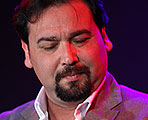Text: Pablo San Nicasio
Photos & vodep: Rafael Manjavacas
October 17th, 2012. Sala Clamores, Madrid
The Big Voice
The Sala Clamores, and especially Antonio Benamargo are putting so much into their October program, it’s become an actual flamenco festival. A miniseries to soothe the savage breast of Madrid flamenco fans, and get everyone in shape, because it’s been a long time coming.
José Valencia’s debut as solo singer in Spain’s capital, coming right after his success at the Bienal and with a recording under his arm, was a dream come true for the young artist.
“Solo Flamenco” is the calling-card of an artist born in Catalonia and brought up in Lebrija, the region of which he considers himself the main flamenco heir. And it’s a recording that has the peculiarity of having been a long time in coming. Although it was a painless birth, we had to wait patiently because of the perfectionist nature of its creator.
José Valencia already had the approval of audiences and critics from years ago, but it took until now to take the final step. Perhaps it was precisely because of the scrutiny to which he would be subjected.
One of the high points of “Flamenco a Chorro” as the series is called, will surely be the “chorro” or torrent of voice from José Valencia, who not long ago had to undergo an operation all too common among flamenco singers, although he still has that big unique voice.
But even so, he didn’t abuse that power except in key moments of the recital. He could have done so from the first moment, in the malagueña and later in soleá. But on stage, he was more meticulous than visceral, starting out in a much more sober way than towards the end.
Although he’s still our friend José Valencia, we had a more rough-hewn impression of the singer from having seen him with dancers…the change from back-up to soloist gives him a more cheerful appearance, without his letting go completely. This is an artist who’s been soaking up cante since he was a child, and he doesn’t make the same kind of concessions to the gallery that other less scrupulous interpreters are so quick to employ.
But always on top of the situation. He administers his faculties perfectly, his job well-learned and with a certain ability to manipulate the tempos as well as audience reaction. In other words, he has what it takes to get to the top in this business.
Tientos, taranta and his bulerías “Jugándome la Vía” wound up the first part.
Where he did let loose the full power of his voice was after some playful cantiñas, when he gave fine proof of his knowledge of siguiriyas. No one can accuse José Valencia of not having laid the groundwork before tackling the denser cantes. More than one veteran singer would take note of these siguiriyas, clearly his territory.
Bulerías de Lebrija, where he commented that he didn’t know the half of these styles. And it may just be true. You’d have to go back to those small towns with your camera and recorder to where today’s knowledgeable singers drew their inspiration. José Valencia is a bottomless pit of wisdom, to the point of being overwhelming, because he does today’s flamenco combined with the most vintage cantes, accompanied by the sobriety and “black sounds” of his sidekick Juan Requena. Together they set the tone just right at the legendary venue Clamores.
The closing was tonás, and some wonderful fandangos for an encore, making this singer the phenomenon of the Madrid’s flamenco season. A true heavyweight who knows almost everything (“almost”, because he’s still young).
The rest of the singers to follow in this series of recitals, most of them veterans, are going to have to look sharp to compete with this Seville interpreter, and it might be harder than they think to be up to the comparison. In any case, what really matters is that the fiesta keeps going before they take it away from us.
José Valencia
